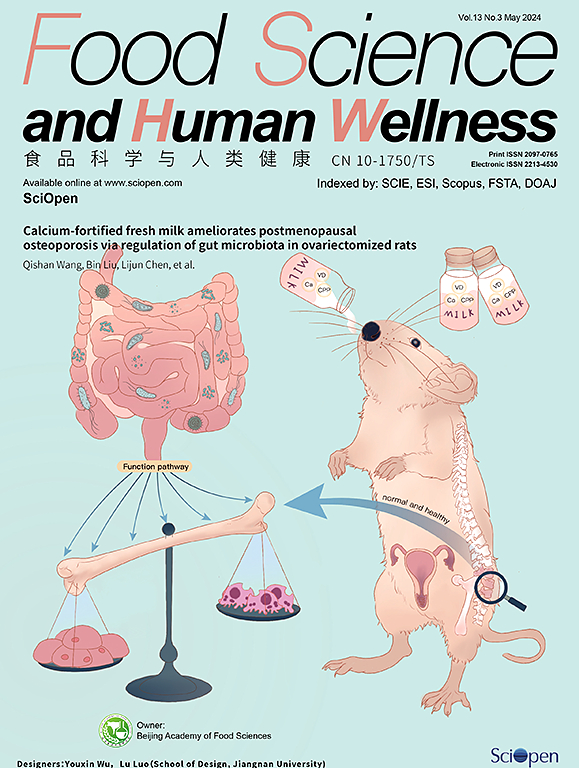Anti-fatigue activity and mechanism of crocetin loaded nanoliposome in acute exercise-treated mice
IF 7.4
1区 农林科学
Q1 FOOD SCIENCE & TECHNOLOGY
引用次数: 0
Abstract
Crocetin displays strong antioxidant, anti-inflammatory and anti-depression activity which is promising to relieve symptoms of fatigue. As a carotenoid, crocetin is difficult to dissolve in water and highly unstable against many environmental factors. Nanoliposome is used to encapsulate crocetin to improve its water dispersion. In the present study, the antifatigue activities and potential mechanism of crocetin loaded nanoliposome (CLN) was extensively investigated. The potential antifatigue pathway of CLN was analyzed. Furthermore, impact of CLN on the gut microbiota structure was examined which contributes to its antifatigue functions. CLN significantly increases exhaustive swimming time of fatigue mice, decreases the blood contents of lactic, blood urea nitrogen (BUN) and malondialdehyde (MDA). At the same time, CLN improves the activity of glutathione peroxidase (GSH-Px) and succinate dehydrogenase (SDH) enzyme, attenuates the oxidant stress in mice. CLN activates the Activated adenosine monophosphate-activated kinase (AMPK)/peroxisome proliferator-activated receptor gamma coactivator-1α (PGC-1α) signaling pathway of fatigue mice, increases the mRNA expression of ATP synthase. It also increases mRNA expression of mitochondrial transcription factor A (TFAM) which promotes mitochondrial biogenesis. Additionally, CLN ameliorates the gut microbiota structure by increasing the abundance of genus such as Lactobacillus in fatigue mice. In summary, CLN exerts strong anti-fatigue properties by decreasing the oxidant stress and the contents of harmful metabolites, augmenting the production of ATP, and potentially ameliorating the gut microbiota structure.

纳米脂质体载体藏红花素在急性运动小鼠体内的抗疲劳活性及其机制
Crocetin具有很强的抗氧化、抗炎和抗抑郁活性,有望缓解疲劳症状。crocetin是一种类胡萝卜素,难溶于水,对许多环境因素具有高度不稳定性。采用纳米脂质体包封西红花苷,提高其在水中的分散性。本研究对番薯素负载纳米脂质体(CLN)的抗疲劳活性及其潜在机制进行了广泛的研究。分析了CLN潜在的抗疲劳途径。此外,还研究了CLN对肠道微生物群结构的影响,这有助于其抗疲劳功能。CLN显著增加疲劳小鼠的竭力游泳时间,降低血液中乳酸、尿素氮(BUN)和丙二醛(MDA)含量。同时,CLN能提高小鼠谷胱甘肽过氧化物酶(GSH-Px)和琥珀酸脱氢酶(SDH)活性,减轻小鼠氧化应激。CLN激活疲劳小鼠活化的单磷酸腺苷活化激酶(AMPK)/过氧化物酶体增殖物活化受体γ共激活因子-1α (PGC-1α)信号通路,增加ATP合酶mRNA表达。它还增加线粒体转录因子A (TFAM) mRNA的表达,促进线粒体的生物发生。此外,CLN通过增加疲劳小鼠中乳酸杆菌等属的丰度来改善肠道菌群结构。综上所述,CLN通过降低氧化应激和有害代谢物的含量,增加ATP的产生,并可能改善肠道微生物群结构,从而具有较强的抗疲劳性能。
本文章由计算机程序翻译,如有差异,请以英文原文为准。
求助全文
约1分钟内获得全文
求助全文
来源期刊

Food Science and Human Wellness
Agricultural and Biological Sciences-Food Science
CiteScore
8.30
自引率
5.70%
发文量
80
审稿时长
28 days
期刊介绍:
Food Science and Human Wellness is an international peer-reviewed journal that provides a forum for the dissemination of the latest scientific results in food science, nutriology, immunology and cross-field research. Articles must present information that is novel, has high impact and interest, and is of high scientific quality. By their effort, it has been developed to promote the public awareness on diet, advocate healthy diet, reduce the harm caused by unreasonable dietary habit, and directs healthy food development for food industrial producers.
 求助内容:
求助内容: 应助结果提醒方式:
应助结果提醒方式:


